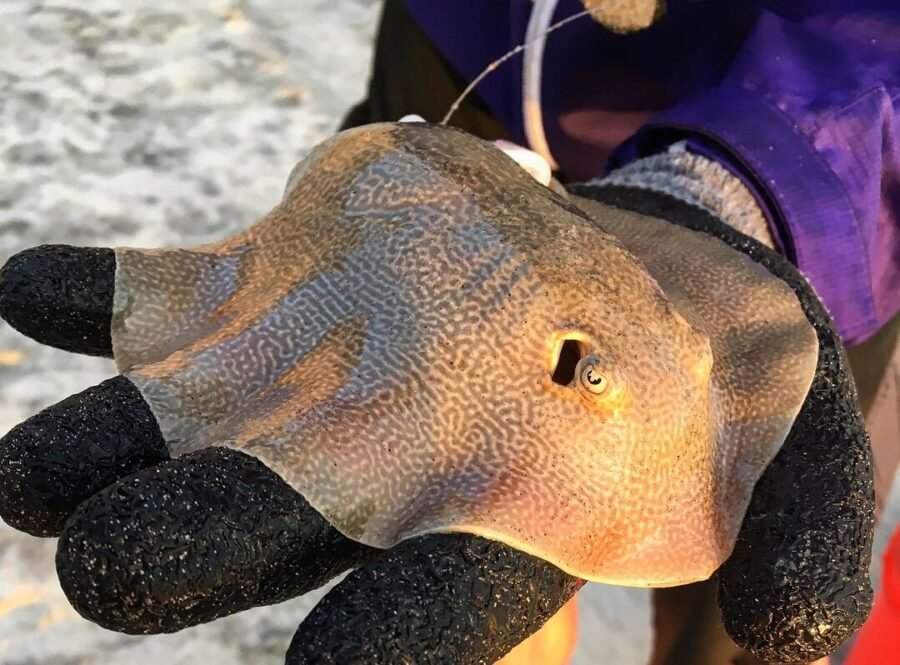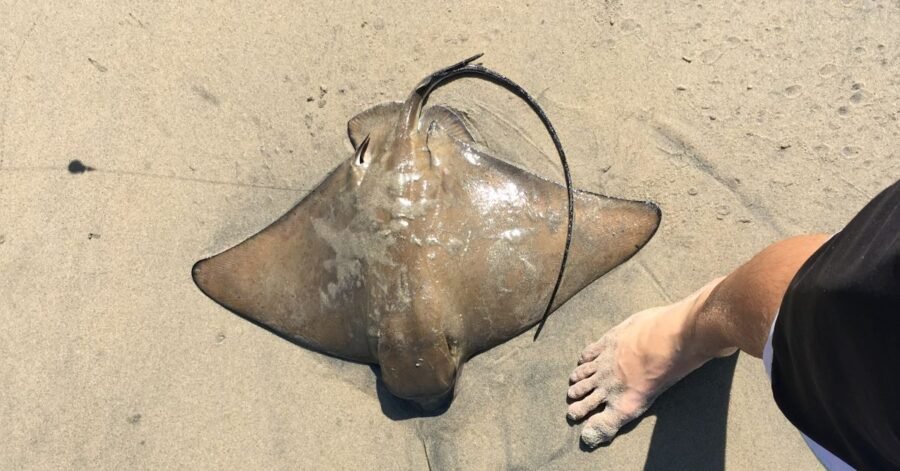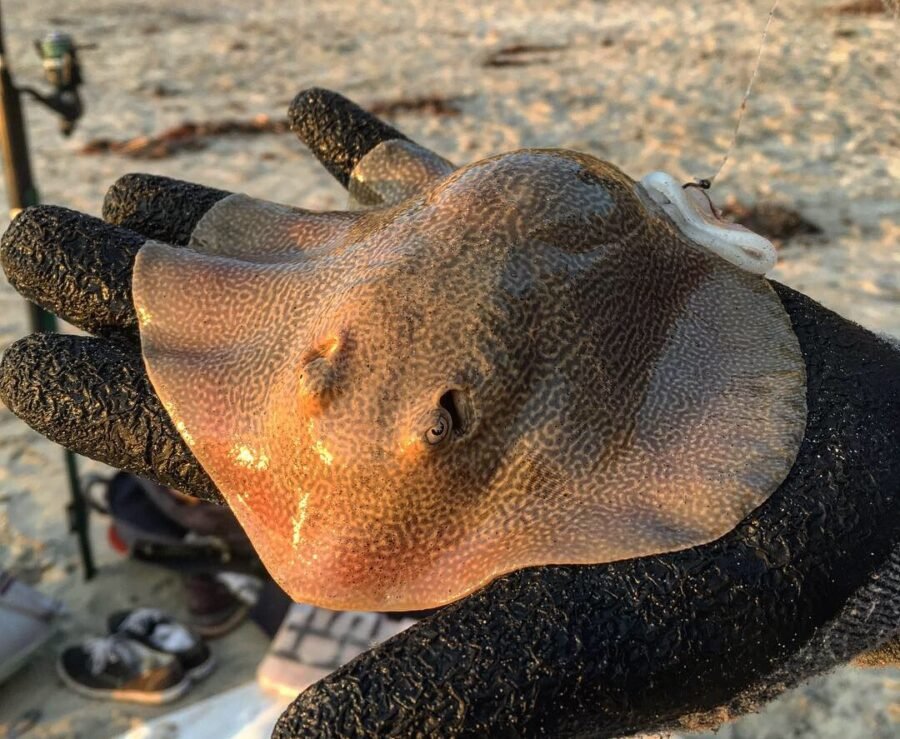How To Handle and Unhook a Stingray The Right Way

So, you either already caught a stingray and realized you don’t know how to unhook it safely or you’re thinking ahead of the game and want to make sure you know how to unhook a stingray without being stung when you do catch one.
In either case, I hope you weren’t stung because it hurts pretty bad. Learning how to unhook a stingray without getting stung is an essential skill for surf fishing. So how do you safely remove a hook from a stingray without: 1.) getting stung and 2.) harming the stingray? Let’s get into it.
Some things we’ll cover:
- Should You Remove the Barb of a Stingray?
- How to Safely Remove a Hook from a Stingray.
- Can You Hold a Stingray?
Don’t Remove the Barb
First and foremost, don’t remove the barb of a stingray. It’s unnecessary and pointless (pun intended). If for whatever reason you go against this advice, consider the next: To remove the barb, treat it like you would a finger nail. Stingrays don’t have feeling in the barb, but they certainly feel pain where it is attached to their body. Don’t rip and pull, just snip it clean. If you snip it, it will grow back, but they will be defenseless against predators.
Whenever I write an article on a searchable topic, I do a little research on what kind of info is already out there and I do my best to fill the gaps and in some cases provide more accurate information. It was pretty shocking to see how all the top results included a recommendation to cut the barb off. For that reason, make sure to share this page on social media and in any other ways you can as it’s important to educate anglers on the topic.
You will not need to remove the barb to safely unhook a stingray, nor should you remove the barb. Understanding the capabilities and observable anatomy of a stingray can help ease your mind about the barb. If you’re going to kill the ray anyway for either bait or eating purposes, that’s a different story.
About the Barb of a Stingray
First, let’s clarify one thing. Stingrays’ tails do not and cannot sting you. In fact, you can grab the tail if you really wanted to. Should you? Not unless you need to or you really know what your doing. Many people don’t actually know that the tail of a stingray is not what you should be concerned about, but rather, the barb. Here’s a close-up on the barb of a bat ray (which will have near identical barb placement as a stingray).

Stingrays use their barb to fend off predators, and given that they spend most of their time on the bottom, they only need to worry about what’s above them. For that reason, their anatomy doesn’t allow for their barb to reach underneath their bodies (for the most part). They may try to reach their barb underneath by curling their tails to either side, but its mostly ineffective.
Where their barb is very mobile and effective is from the top. They use their barbs like you would imagine a scorpion using its stinger. Their tail shoots up overtop their body and they drive the barb into whatever might be seen as a predator. This is why many stingray wounds occur on the sides and tops of people’s feet and even in the sides of their ankles. So, let’s talk about how to safely remove the hook from a stingray.
3 Ways to Safely Remove the Hook from a Stingray
There are three methods that I commonly use when unhooking a stingray from my line. I’ll be explaining them in the order of best options in my opinion. With all of these methods, I recommend using pliers.
Option #1 | Don’t Even Touch the Stingray
Your best and easiest method will be one where you don’t even need to touch the stingray. I recommend this be your go-to. In short, you leave the ray in the water until you have your pliers ready. Once you have your pliers in hand, grab the hook and shake the ray off. This is the safest method for an angler and if done smoothly, the safest method for the ray as well. It’s very simple, very straight forward and easy to get the hang of.
- Step 1: Leave the ray in the water while you place your rod between your arm and your body to free both hands.
- Step 2: Grab your leader with one hand and hold your pliers in the other.
- Step 3: Lift the ray out of the water (by your leader) and grab the hook with your pliers.
- Step 4: Make sure your grip on the hook is down from the shank and ideally on the arch.
- Step 5: Hold the ray away from your body and feet.
- Step 6: Invert the hook so that the ray falls off the hook and back into the water.
Option #2 | Leave it Right-Side-Up
In this method, we’ll bring the stingray onto dry, compact sand and leave the it right-side-up as we reach into its mouth with our pliers to unhook it. This can be a little difficult if the hook is slightly swallowed. In that case, I would flip it on its back and unhook the stingray that way. Usually a size #2 or #4 mosquito hook will remain at the edge of a stingray’s mouth.
- Step 1: Drag the stingray up onto the dry, compact sand where the waves will not reach you.
- Step 2: Use a finger to raise the snout (front) of the ray so you can see the hook.
- Step 3: Grab the hook with your pliers.
- Step 4: Make sure your grip on the hook is down from the shank and ideally on the arch.
- Step 5: Push the hook opposite to how it went in the fish’s mouth.
- For next steps, refer to the section below on how to hold/carry a stingray.
Option #3 | Flip it Over
This is option number three solely because of the skepticism around the idea that flipping stingrays on their backs is bad for them. I’ve come across no research that indicates this to be true, but if I can avoid it, I do. Personally, I don’t think it’s any worse for them to be on there back as it is for them to be out of water, but I’m sure they’d rather be right-side-up.
- Step 1: Drag the stingray up to the dry and compact sand where the waves will not reach you.
- Step 2: Grab your leader to flip the ray over (or flip over by sliding your hands underneath).
- Step 3: Place your other hand on the belly of the stingray and apply light pressure to hold it down.
- Step 4: Make sure your grip on the hook is down from the shank and ideally on the arch.
- Step 5: Push the hook opposite to how it went in the fish’s mouth.
Continue reading for how to safely release the stingray.
When handling a stingray, don’t place your hands anywhere near the base of the tail and don’t grip anything from atop the stingray. If you place a hand anywhere on the topside of a stingray, there’s a chance it could sting you. This leads to the next thing I want to cover. Can you and should you hold a stingray?
Is it Safe to Hold a Stingray?
Do you need to hold or carry a stingray? Usually not, so I would advise against it if you don’t know what you’re doing. Sometimes, situations might require that you hold or carry a stingray back to the water if you’ve brought it too high up onto the sand and we can talk about the safest way to hold a stingray if you find yourself in such a situation.
Is it safe to hold a stingray? Yes, if done correctly. When I need to carry a stingray back to the water, I prefer to keep them under as little stress as possible and do as little damage as possible. It’s best to not grab the tail with pliers, but that is also an option if you have yet to learn the following techniques.
How to Hold/Carry a Stingray

- Step 1: Again, make sure the ray is on the dry, compact sand or where the waves won’t move the ray (if you’re already near the water, you won’t need to pick up the stingray).
- Step 2: Make sure the stingray is lying on the sand in a right-side-up position.
- Step 3: Slide your hand(s) (in a supine position) underneath the ray’s belly (as illustrated in the images).
- Step 4: Walk the ray out to the water and either set it down or drop it from a low height.
Hopefully this helps you feel a little more comfortable about handling and unhooking a stingray without getting stung. The best way to learn is by going out there and getting some experience. And worst case, just snip your line at the hook. It’s not ideal, but it’s a last resort option that isn’t so bad at the end of the day.
Looking to start surf fishing? Here’s all the gear and tackle I use for surf fishing. It really isn’t much. Below is a quick overview while the link goes into detail as to why I use what I use and when.
- Rod: Okuma Celilo (8’6″ MA) or the Okuma SST (8’6″ MA)
- Reel: Penn Battle II or III 4000 series
- Mainline: 15-pound monofilament
- For Bait: Carolina Rig:
- Leader Line: 15-pound fluorocarbon
- Swivels: 15-19mm barrel swivels
- Hooks: size #2 or #4 owner mosquito hooks
- Weights: 1-oz egg weight
- Beads: 8mm fishing beads
- For Lures: Lucky Craft FM 110 and Shimano WM 115 SP
- Other best surf fishing rods and best surf fishing reels
Subscribe to our newsletter!
This is very useful info, Nick, thank you! Your Scorpion comparison really helped me to visualize how they sting.
Absolutely! Thanks for the appreciation, Kurt. Merry Christmas!
Good stuff.
I have a Sting Ray wallet. No better material on Earth for the purpose.
Would appreciate elaboration on ‘eating’, you mentioned? Never heard of using them for bait?
Great attitude. We used to night fish in San Diego Harbor, many many moons back – before newbies started calling it a “Bay”. Huge Rays. 6-10/0 hooks w/ a whole Bonita. A brutal shame people killed them, chopped tails off, leaving noble fish helpless to die pecked to death by trash-fish.
Rays clean the bottom/rocks of decomposing debris – which otherwise simply decays, creating large amounts of Nitrogen, increasing Red Tide’s food source and bacteria that weakens the fish-stocks under attack by the accelerated phytoplankton growth. As more fish die from the neurotoxins, more food (rotting nitrogen source) is created and a critical point is reached, resulting in mass fish die-offs. So protecting by-catch is critical. This affects any fish that contacts the poison; Halibut; Perch; Cabazon; Corbina.
–
Thank you for providing sound understandings that temper our predatory instincts/ fears with knowledge and make us truly worthy Masters of our planet.
Please don’t stop!
Paul
Thanks for the detailed write-up, Paul! Unfortunately, I have no experience eating sting rays or bat ways, but there are some good resources on youtube and other platforms.